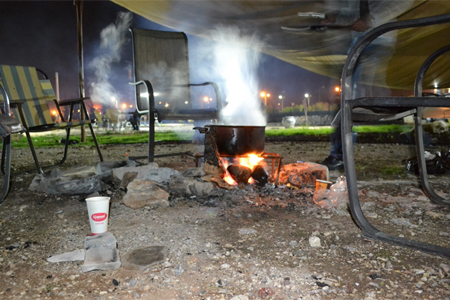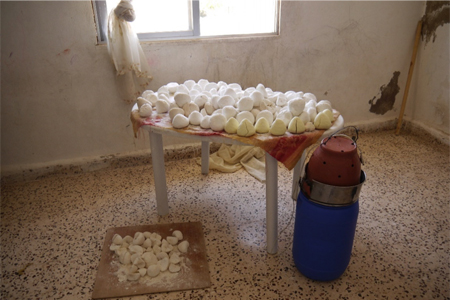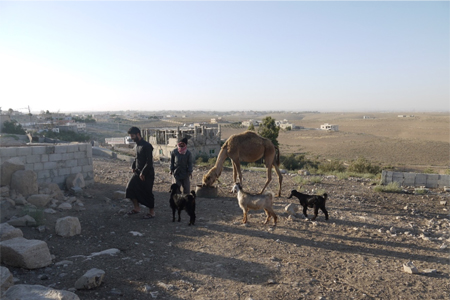Fieldwork in Jordan
My fieldwork was in Jordan, in the town and surrounding villages of Madaba; a rural area just south of the capital Amman. I wanted to explore questions of identity, elite reproduction and political participation in this largely sedenterised Bedouin area. My wife, who had her own interests in the region as an archaeologist, accompanied me and worked on her own project, but shared in many social occasions with my interlocutors’ friends and families, inevitably relating to them in different ways and entering different gendered worlds. These photos, which were mostly taken by her (a more accomplished photographer), represent something of our shared experience of being strangers and recipients of hospitality, trying to build relationships and to situate ourselves in the social world around us – a necessarily partial project. As such, we have produced a joint submission, reflecting the joint (indeed multi-person collaborative) nature of ethnographic production.
These three photos show different elements surrounding a key symbol of Bedouin hospitality (Karām); the production and serving of Mansaf. Often termed ‘Jordan’s national dish’, it consists of meat (preferably a freshly-killed and dismembered goat or sheep) stewed in jamīd (a sauce made from dried fermented yoghurt), and served on rice or grains and shrak (paper-thin, home-made, griddle-cooked flat-bread. Discursively contrasted with khubz; thick, shop-bought, oven-baked bread. While most rice dishes are now eaten with a spoon, mansaf must, it is said, be consumed with the right hand alone. Once a celebratory dish among nomads, through a complex process of colonial effect and deliberate effort to produce a national culture through putatively tribal symbolism, it has become an essential component of hosting and hospitality throughout Jordan, being more or less mandatory at certain occasions and for important guests. This dish is strongly associated across the region with ideas of Bedouin-ness, pastoralism, and self-sufficiency - especially the meat and dairy products involved, which are still produced by Bedouin households for domestic consumption or to supplement income. Even town-dwellers admit that shop-bought jamīd is a poor substitute; an area of the economy of consumption and commensality where the autonomy of both the nation and of agnatic kin-groups is emphasised over other market-influenced dishes. The complex relations to settled agriculture behind the cereal components are obscured in such accounts. Learning about mansaf, to eat it properly by hand at formal occasions in the dīwāns (formal semi-public guest-rooms) of men of influence, and to make it properly (Jennie was often invited to visit older women for impromptu cooking lessons), was an activity the importance of which was constantly stressed to us by our friends and interlocutors.
Making Mansaf: the interplay of identity and political economy in Jordan’s national dish

Mansaf cooked over a fire at a stable on the edge of Madaba with young men from the al-Fayiz Bani Sakhr, after a day of riding. Men in Jordan generally shun cooking in a domestic setting, but cooking over fire it becomes core component of Bedouin masculinity, and a theme for self-portrayals on for social media, especially making valourised foods like Mansaf. The young men prepare the fire, meat and coffee, we chop parsley and brown almonds to garnish, while ready-cooked rice (a colonial-era edition to the dish) and bread, is brought in from home, cooked by the host’s mother.

Blocks of Jamīd drying next to an improvised modern butter churn (replacing the use of dried goat-skins) in the home of a Bani Hamida woman in the remote village of Ad-Dyr in the Jabal Bani Hamida district; domestic production remains central to conceptions of dairy products and Bedouin identity in this area, and Bani Hamida dairy products are renowned throughout Jordan. Produced, sold and mostly used by women, they also embodies gendered divisions in production that remain in a sense exemplary for discussing gender with outsiders. The gendered conceptions of space are also highlighted through absence in this picture; the maker of the Jamīd refused to be in shot.

Two men, cousins, from the Dahamshah Bani Sakhr Bedouin meet by the ruined old centre of the Dahāmshas’ village of Um al-Walid. Despite the closeness of their families, the relationship between them is strained. On the left, my friend Hamid, who commutes daily to his job at the Ministry of Finance in Amman, walks away from his older cousin Abu Ahmed (right), who still works as a herder, and had reared the goat for the Mansaf we had just eaten. Hamid had taken me up to the old Tell site, which is in part built into the ruins of an Umayyad palace, to see both the ruins and to see the large new modern house his brothers are building, rising up in the background. Abu Ahmed, his grandfather’s brother’s son, raises camels, horses, sheep and goats. Small-scale production of meat and dairy, unprofitable since Neo-liberal reforms and structural adjustments ended animal feed subsidies, remains symbolically and socially central to conceptions of hospitality, honour and status, especially being able to produce a Mansaf. Abu Ahmed, born in a goat-hair tent, was chosen by his family to look after the animals as his brothers and cousins got jobs away from the village. A father of 10, he relies on hand-outs from his relatives, while living in an older, smaller house, selling them animals at cost when they need them for important occasions. Ahmed asks Hamid what he is doing, and seems exasperated at Hamid’s suggestion that we take a picture with his Camel – ‘what for?’ he asks, ‘haven’t you people seen a camel before?’, eventually relenting, agreeing to this picture and inviting us to share a glass of sweet tea with him.
